Windshield replacement in a vintage car (Part 1)

If you’re driving down the road in a late-model car, and the vehicle in front of you kicks up a rock that cracks your windshield, it’s not really a big deal. The combination of readily-available glass, the good condition of the rest of the car, the likelihood of insurance coverage, and the reasonable cost even if you have to pay for it out of pocket, makes the process relatively painless. These days you probably don’t even have to go anywhere, with many glass companies offering in-driveway windshield replacement.
However, it’s different you buy or own a vintage car with a cracked windshield. While a website like Safelite’s is great at being able to tell me that a windshield for my 2003 BMW 530i, with rain-sensing wipers, is $355 installed, these click-and-estimate tools don’t apply to most vintage cars.
Why not? Several reasons. First, the windshield itself—a high-volume glass company might not be able to procure a boutique product for your vintage ride. Second, the method of installation. Most modern windshields are flat, or nearly, and are held in with adhesive. In contrast, the glass on many pre-1970 cars had a lot more curvature and was typically held in with a rubber gasket, usually with a locking strip.
But the biggest reason that a commercial glass shop probably won’t be able to replace the windshield in your vintage ride is that if the glass hasn’t been replaced in 40 or 50 or 60 years, it probably isn’t coming out without a fight, and the area underneath it may need work that’s outside the wheelhouse of glass replacement.
I’ve been through this with two of my BMW 2002s. The first was “Louie,” the decade-dead 1972 2002tii I bought sight-unseen in Louisville in 2017 (you can read about it in my book Ran When Parked).
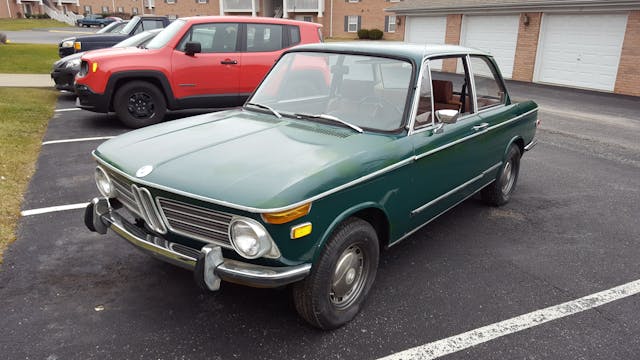
The windshield wasn’t cracked—in fact, it was in remarkably good, un-pitted condition—but the gasket was so shrunken and hardened that it was effectively porous, and when I hit rain on the drive home, enough water pooled on the floorboards to make a family of salamanders very happy.
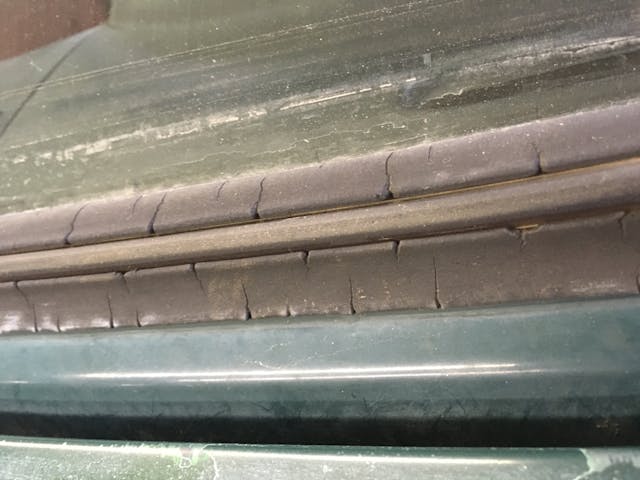
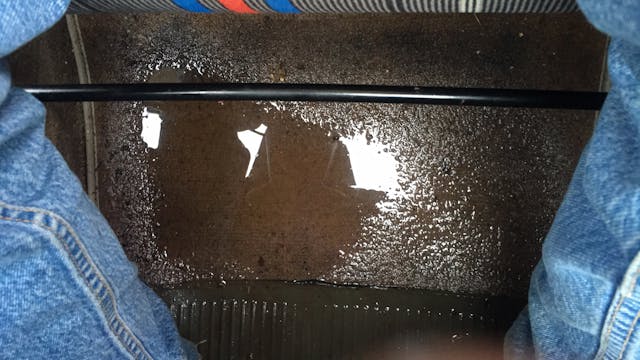
The gasket proved to be as tough as alligator skin. After removing the plastic lock strip, I tried to cut the gasket out with a utility knife. It was the kind of half-inch-at-a-time work that, if the knife slipped, threatened to sever arteries and tendons. Initially I thought that I needed to cut both down into the gasket where the lock strip had been and then across, but eventually I found that I could simply cut across and lift the cut gasket out of the way. This sped things up quite a bit.
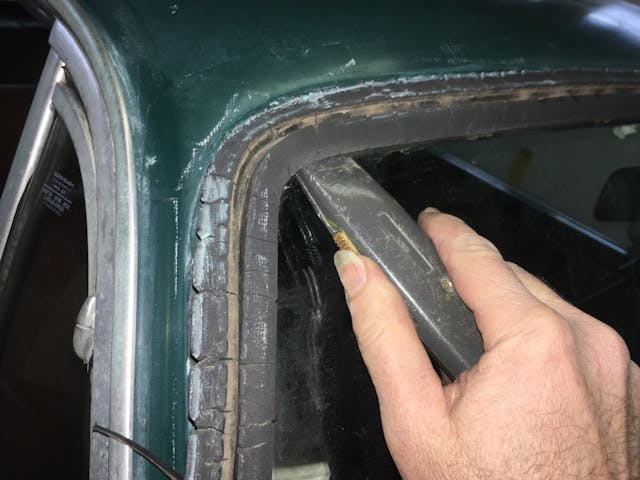
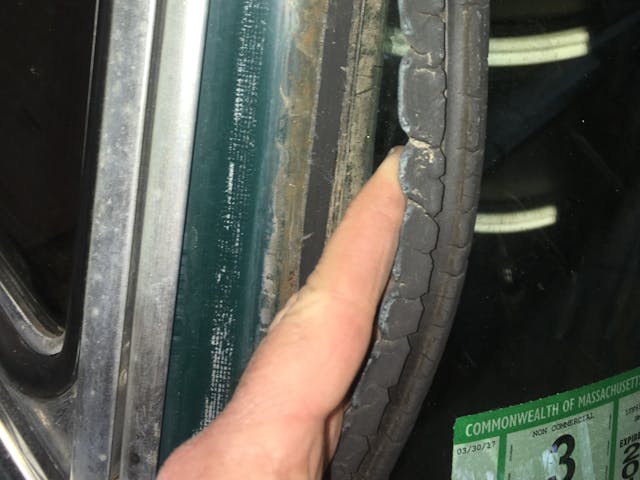
Once I’d cut through the gasket, I was able to press the windshield out from inside. However, the remaining hardened portion of the gasket was attached to the windshield frame. While there were some large chunks that pulled off, many small sections held on like barnacles. It was like removing old grout between tiles. I threw everything at the problem: fingernails, a plastic scraper, acetone, Scotch Brite pads, a Dremel tool, single-edged razor blades, and a metal scraper. Not surprisingly, the metal tools worked the fastest but had the most deleterious effect on the paint. Since Louie had a fair amount of patina on it—the previous owner had treated some rust blisters by sanding them and then spraying Hunter Green hardware store paint—I wasn’t as horrified by this as you might think.
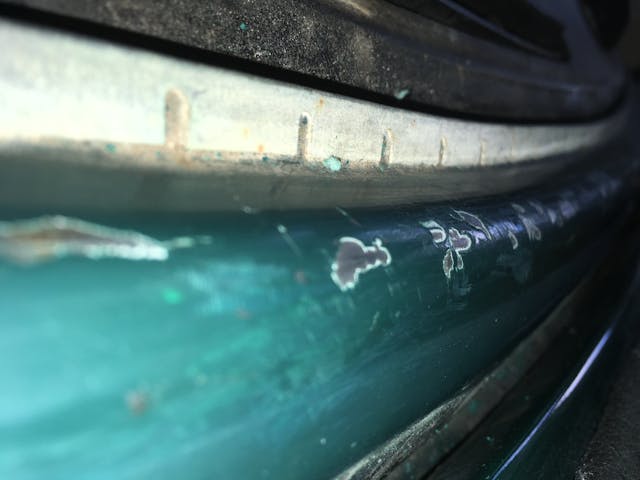
Removing the windshield and gasket exposed two things. The first was an odd, toothed clip that ran around the inside of the windshield frame. This turned out to have been installed by the factory in all BMWs between certain dates as a response to Federal DOT-mandated requirements about keeping the windshield secure in the event of collision.
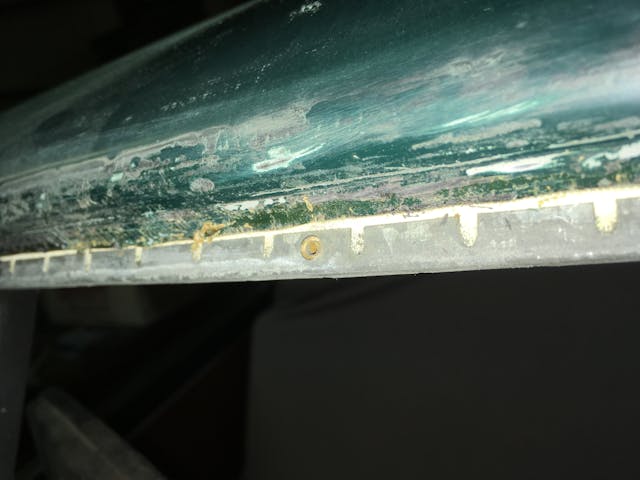
But the more troubling thing was the presence of rust on the driver’s-side A pillar.
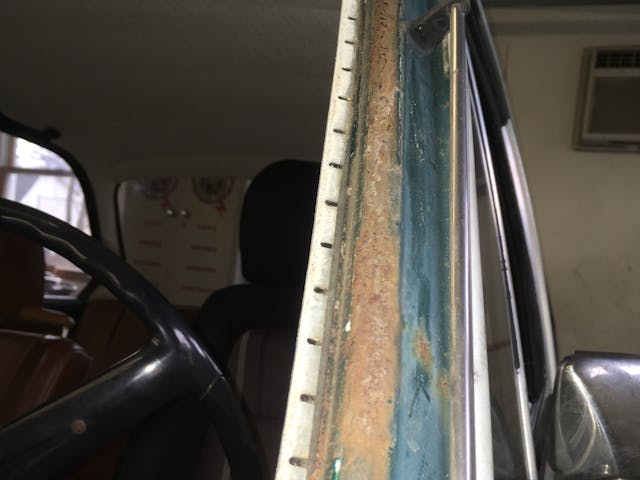
I carefully ground the rust down and found pitting but no actual perforations, so I elected to treat it with Rust-Oleum Rust Reformer, one of several rust conversion / encapsulation products.
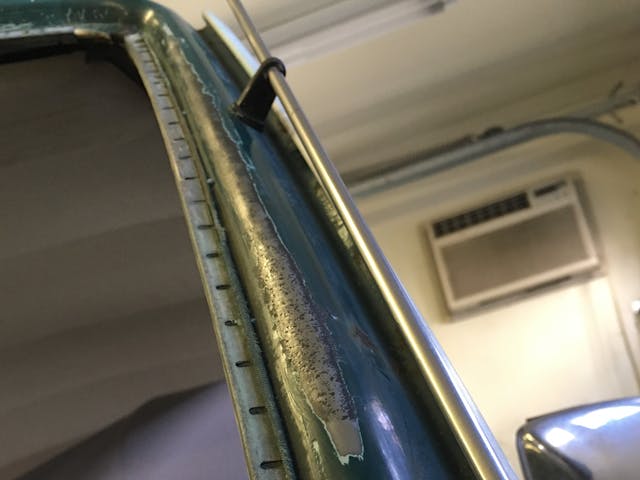
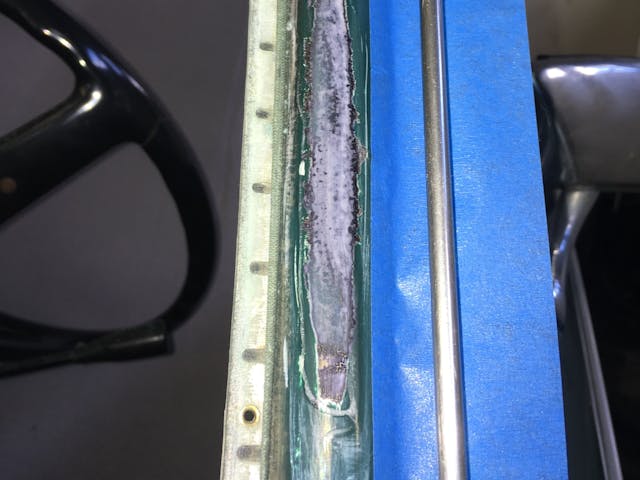
Not wanting a windshield gasket replacement to mission-creep into an outer body restoration, I simply primed this section and anything else I scratched or shipped and painted it with the same color Hunter Green paint that was previously used elsewhere on the car.

The windshield and new gasket were ready to go in. For this, I elicited the help of my friend Lindsey Browne, shop foreman at The Little Foreign Car Garage in Waltham, Massachusetts, and a fellow 2002 aficionado. Lindsey had previously explained to me that they used to use a glass guy who had a lot of experience with vintage cars, but he retired, so now they were doing most of their own glass installations. I said something to him like, “So, you know how to do the rope trick to flip the lip of the gasket, right?” He said yes but cautioned me that this is sort of the “stick the landing” part of windshield replacement—the part that everyone knows to comment about but is usually a relatively small portion of the whole routine. “There’s also a lot of prying, shoving, slapping, and cursing involved,” he said.
What’s meant by doing “the rope trick” to “flip the lip”? Rubber windshield gaskets have an inner groove in which the glass sits, and an outer groove into which the windshield frame needs to seat. The problem is that, like installing a rubber grommet in a hole, the inside-facing lip is larger than the opening in the windshield frame, so to get the frame to seat in the gasket, the inside-facing lip has to be coerced to come inside an opening it’s too big for.
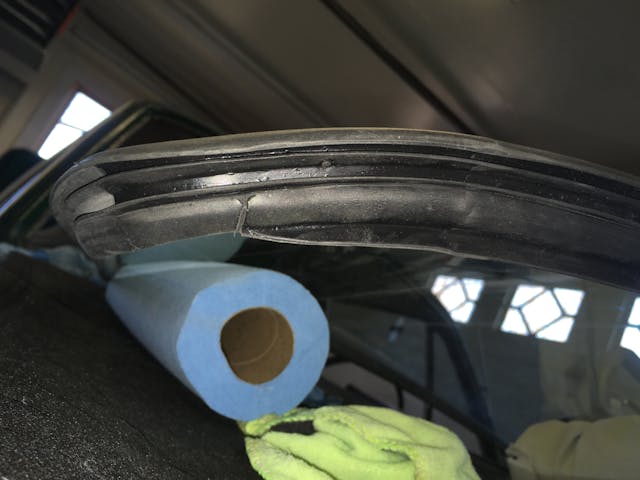
The time-honored method of doing this is to goop up the groove with something slippery but non-permanent like Gojo lanolin hand cleaner, take a length of thin rope, slide it into the groove all the way around the gasket, then begin inserting the windshield and gasket into the frame, and slowly and carefully pull the rope out from the inside so it pulls the inside-facing lip of the gasket over the inside edge of the windshield frame.


I’d watched a few videos of this, including one of a friend of mine demonstrating it at a vintage BMW event. Mine did not go nearly as easily. There were a few reasons why. One is that, if you look at the photo of the gasket (above), you see not just one groove and two lips, but several of each, so there are actually multiple lips that need to be flipped. Another was that, particularly at the bottom, the presence of the toothed clip exacerbated an almost impossibly narrow space for the thick rubber gasket to pass. A third was that once the gasket began to seat, the degree to which the glass could be slid side-to-side was almost nonexistent, so twice we needed to pull it out and start over.
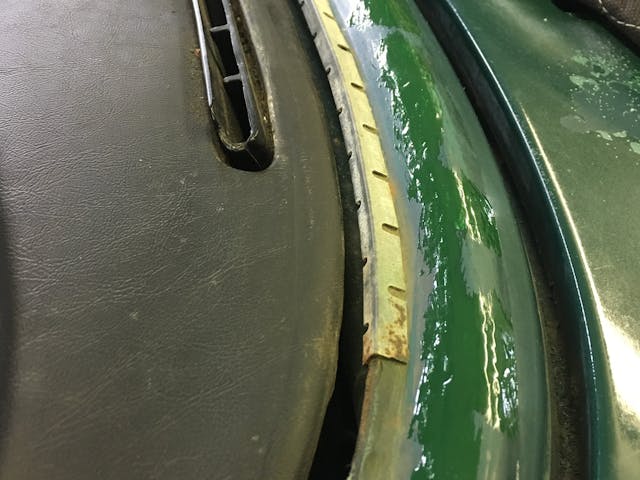
But the main culprit was that pulling the rope and flipping the lip in no way guarantees that the windshield frame is actually seating in the central groove of the gasket. This issue was greatly exacerbated by the presence of the toothed clip, as it prevented the lip from easily flipping over and made it more difficult for the gasket to seat. In the narrow dashboard gap on the bottom and other areas, I had to manually intervene with a tool jury-rigged with a pair of Vise Grips and an Allen key employed to reach in and pull the inner lips out of the way.

Eventually we got it close except for the left side being high. This was dealt with by the kind of force that Lindsey warned me about.

After we were done, I read that there used to be an OEM gasket made specifically for cars that had the toothed clip, but the part number had been superseded by that of the clipless gasket, and what I should’ve done was drill out the rivets and remove the clip. D’oh!
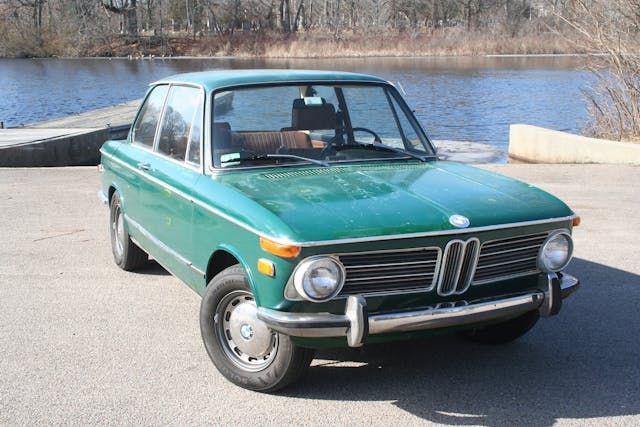
I had the opportunity to do it all again when I bought back “Bertha,” the 1975 2002 my wife and I had driven from our wedding in 1984. It too had sat for decades, had rust blisters the size of dinner plates on the hood, a cracked windshield, and a rock-hard gasket that had to be cut out.
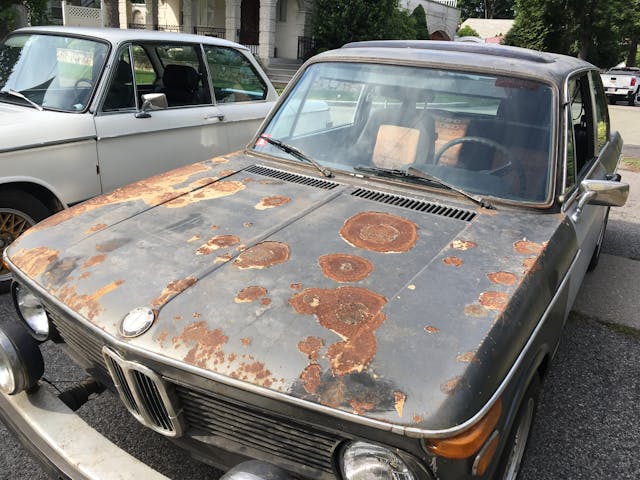
When I removed the windshield and gasket, I found that Bertha did not have the problematic toothed clip but had rust on one of the A-pillars that, when ground down, revealed two actual perforations.

Since Bertha is a car that wears patina with a capital P, I was even less concerned about a do-it-once-do-it-right approach than I had been with Louie. Launching into an A-pillar replacement would’ve been expensive, so I treated the area with naval jelly, painted it with rust reformer, patched the small perforations and filled the divots with POR-15 Patch and Seam Sealer, sanded that down, then primed and painted it.
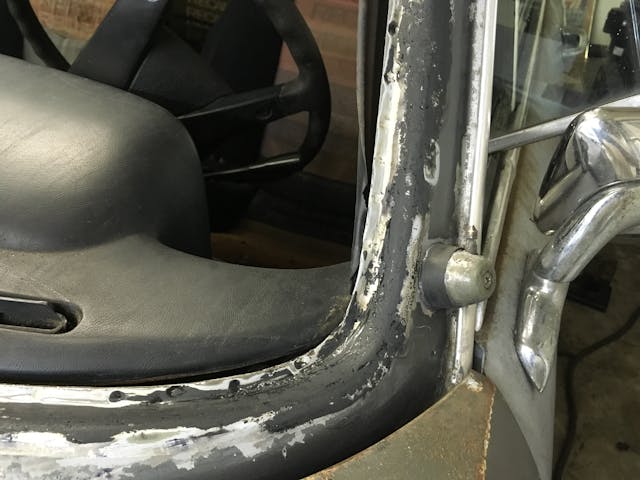
I sourced an inexpensive, used windshield from someone local, and Lindsey again came over and helped me with the installation. Even without the dreaded clip, it was still a bear, requiring insertion of a hooked pry tool to pull the lip inside the windshield frame.
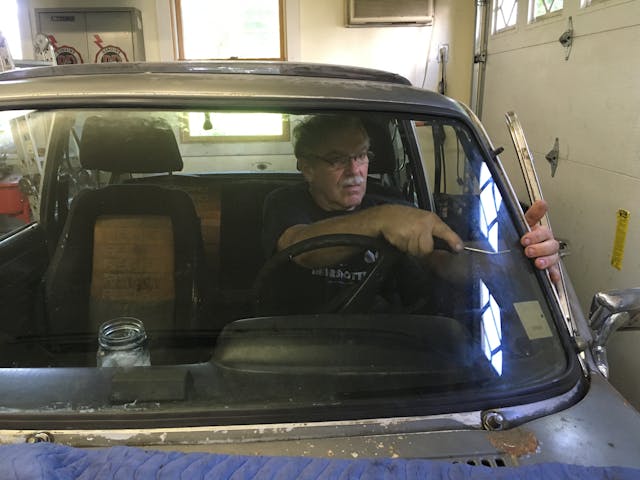
We reached the same point that we did with the windshield on Louie, where the section along the driver’s A pillar wasn’t quite seated. We did the same shoving and slapping as last time, but unfortunately, this time the windshield cracked.
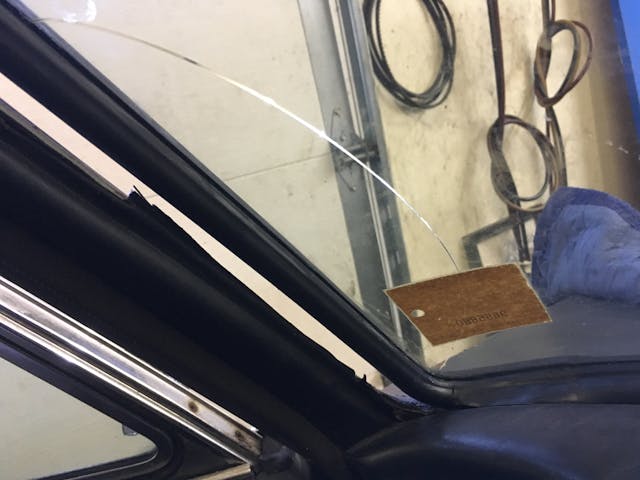
This is part of the advantage of having a friend who is a pro and owns the same car. Lindsey said, “I’m pretty sure I have another windshield at the shop. I’ll be back in an hour.” Sure enough, an hour later, another used windshield rolled into my driveway. For whatever reason, this one went in a bit easier.
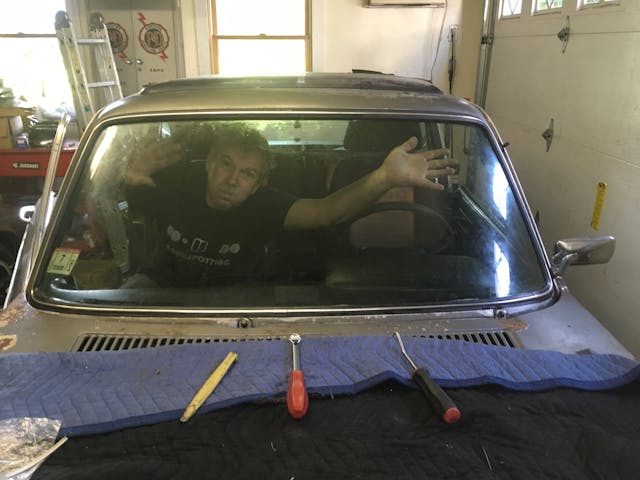
The takeaway from all this is several-fold. If you have a car with an old, hardened gasket, odds are the gasket is binding tightly to the windshield frame and the remnants will have to be chipped or scraped off. This alone is likely to rule out a Safelite-like service in favor of a classic car specialty repair shop. If the gasket removal damages the paint, and the car is pretty enough that that matters to you, you’re looking at taking it to a body shop for paint matching and touch up. If you find rust perforations on the windshield frame, it’s more in the purview of outer-body restoration.
For all these reasons, it’s unrealistic to think you can handle windshield or gasket replacement in a classic car in the same way as a late-model car, where it’s done in your driveway, or you drive in and out as if it’s an oil change.
However, I have a high tolerance for imperfection and am quite good at containing mission creep, so I did it myself, preventing a windshield and/or gasket replacement from slippery-sloping its way into what probably would’ve been several thousand dollars of sheet metal work and paint-matching. I was thrilled, with help from a friend, to get this done on two cars for just the cost of the materials.
I not only would do it again, I am doing it again. Next week, we’ll go through all this with my little fiberglass-bodied Lotus Europa, whose cracked windshield is held in not with a gasket, but with adhesive.
***
Rob’s latest book, The Best of the Hack Mechanic™: 35 years of Hacks, Kluges, and Assorted Automotive Mayhem is available on Amazon here. His other seven books are available here on Amazon, or you can order personally inscribed copies from Rob’s website, http://www.robsiegel.com.
Check out the Hagerty Media homepage so you don’t miss a single story, or better yet, bookmark it. To get our best stories delivered right to your inbox, subscribe to our newsletters.


Rob, great insightful article. Always wondered how you got those gaskets to fit on the windscreens of foreign cars. One question, I understand that the bosses at the insurance company, whoops I mean lifestyle company that employees you has laid off people and cut the pay of the remaining writers and contributors. Just great you are still around as my brothers youngest girl has a townhouse off Beacon St and Boston is so expensive. I don’t know how you could afford a pay cut but we are glad you are still around.
I’ll be waiting for the report on the Lotus windshield transplant. I’m sure there will be something new learned about the ways those cars were constructed under Sir Colin Chapman, CBE. The Europa was my favorite car when I was a kid — so low to the ground. They can still look as good as anything on the road, and I understand your ownership.
I have done, redone, and re-redone this job. The killer app for me (with my long suffering wife’s assistance) was to use a thinner nylon rope wound around the gasket twice. I think it took four attempts to get this right even with a lot of soapy water and a hot sunny day to keep that gasket pliable. The inner gasket would not stay put on the corners until the second pass of the cord, and then, like magic, it sucked into the car. I enjoyed the feeling of victory, but I would not look forward to doing it again.
Lovely article. It has certainly convinced me to leave the gasket replacement on my E-100 to the pros (my glass is fine). Now to find a shop that has experience with older cars.
Thanks.
Gluttons for punishment! I’m sure it felt good after it was done.
Excellent article! Confirms that it wasn’t just me (and my wife) that had so much trouble with the rope trick. After several attempts we gave up and got a glass installer in that knew what he was doing and made it look fairly easy. After watching how carefully he treated the windshield I was shocked that we didn’t crack it with how brutal we were treating it as the installation attempts progressed (not sure “progressed” is the correct word though).
One thing I disagree with is “Most modern windshields are flat, or nearly”. Really? Haven’t seen a flat or nearly flat windshield in decades.
The huge hood of that M Coupe in the background looks like it is making a perfect storage shelf or work area.
When I did all the windows on my 73 VW I used the nylon string from a weed eater. Managed to get them all in with no breakage. Not bad for my first attempt at window installation. Anxious to hear how the Europa goes.
There is just no getting around the prying, digging, poking and cajoling needed to replace vintage windshield glass. However, a great inexpensive and indispensable tool is a glass suction handle. Makes the placement and maneuvering so much easier, safer and less prone to breaking. Best part, a good one can be had for less than a couple sawbucks!
I concur with you, Rob – curved windshields are a real bear to install. After painting my late 60s International pickup, the relatively flat front and rear glass went in smoothly with the rope trick. My wife volunteered to assist, and soon she was telling her friends that she was now a skilled windshield installer.
Fast forward a few years and our 59 Edsel needed the windshield replaced. It has curves the size of Bridget Bardot! We had it in and out probably a dozen times, never could get both sides of the windshield in at the same time. I finally gave up and located a vintage glass installer and wrote a check. Even he was cursing over the job!
Rob, I wonder if a oscillating tool might help with the gasket removal and surface prep. They are easy to control and have precise action. Having lived in Newton for four years I did not realize that there is a car culture in the Boston area. I was still getting auto excise tax bills long after I had relocated. It is good to see the lengths that you go in order to keep older classics on the road.
Would using a heat gun to soften up the old gasket help? I find myself reaching for the heat gun a lot when I’m working with old rubber parts that have become deformed or just inflexible. Might help with the new gasket installation as well.
Rob, you live an interesting life…
I had a local auto glass company install the windshield with a “flip the lip” type gasket in my 63 Rambler. I provided the repro gasket. They assured me they could handle the job. Apparently they only put them in for people with trailer/garage queens. Mine was a daily driver,and they were told this from the start. First time I drove it in rain it leaked nearly all around. No rusted/damaged lip or anything, they just used NO sealer — just the gasket. Since it had been less than 30 days I was able to pull the windshield and re-use the gasket. I was a little intrigued when Rob mentioned using GoJo or something similar. The AMC/Rambler TSM (Technical Service Manual… factory repair manual) specifically states to use a sealer under the lip. This makes for a messy install, especially on the side. I always put the gasket on the windshield with a little sealer in the glass groove, Then put sealer on the body where t he gasket will seat. Masking tape and wax paper on the inside because you WILL get sealer on the string as you pull, and on the gasket lip. Paint thinner/mineral spirits/alcohol to clean the mess off the tape/wax paper (and hands) before removing. so I ended up doing the job myself and 20 years later I still don’t have leaks.
Well after 5 years of driving around with spider cracked windshield on my 73 3.0 CS . I found a new windshield preceded to push out the old one with feet. That was easy enough on to the install! Let the games begin. New rubber onto the glass insert cord set the windshield on a blanket position center. Oh my I have 4inches plus on both A pillars to close up the gap!! Out comes the 3inch tie down (no pounding nescasary) ratchet it in to place slowly constant pressure pull the cord slowly it will go in and the glass will bow and conform to the car and it does not LEAK YAHOO takes about 4hrs by yourself and work slowly!!! good luck